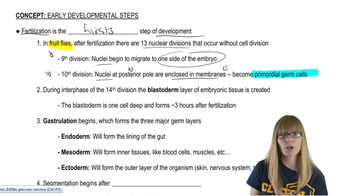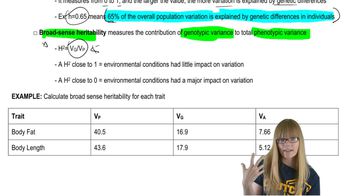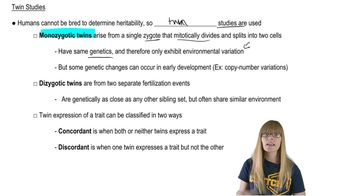Table of contents
- 1. Introduction to Genetics51m
- 2. Mendel's Laws of Inheritance3h 37m
- 3. Extensions to Mendelian Inheritance2h 41m
- 4. Genetic Mapping and Linkage2h 28m
- 5. Genetics of Bacteria and Viruses1h 21m
- 6. Chromosomal Variation1h 48m
- 7. DNA and Chromosome Structure56m
- 8. DNA Replication1h 10m
- 9. Mitosis and Meiosis1h 34m
- 10. Transcription1h 0m
- 11. Translation58m
- 12. Gene Regulation in Prokaryotes1h 19m
- 13. Gene Regulation in Eukaryotes44m
- 14. Genetic Control of Development44m
- 15. Genomes and Genomics1h 50m
- 16. Transposable Elements47m
- 17. Mutation, Repair, and Recombination1h 6m
- 18. Molecular Genetic Tools19m
- 19. Cancer Genetics29m
- 20. Quantitative Genetics1h 26m
- 21. Population Genetics50m
- 22. Evolutionary Genetics29m
20. Quantitative Genetics
Heritability
Problem 30
Textbook Question
Congenital dislocation of the hip is a threshold condition in which the head of the femur (the femoral head) is out of its normal position relative to the bones that will form the socket of the hip (the acetabulum). This misplacement can lead to potentially serious orthopedic problems later in life if the condition is not treated in infancy. Numerous studies have shown that (a) brothers and sisters of infants born with congenital hip dislocation are more likely to develop the condition than are the siblings of those without the condition. These studies also find that (b) more female infants than male infants have the trait, and (c) if the affected child is a girl, the risk to her siblings is lower than if the affected infant is a boy. Explain the meaning of the three observations (a, b, and c) in the context of proposing a threshold model that explains these observations.
 Verified step by step guidance
Verified step by step guidance1
<Step 1: Understand the threshold model. A threshold model in genetics suggests that a trait is expressed only when a certain genetic and/or environmental threshold is exceeded. This model is often used for complex traits that do not follow simple Mendelian inheritance.>
<Step 2: Analyze observation (a). The increased likelihood of siblings having congenital hip dislocation suggests a genetic component. This implies that the trait has a heritable basis, and siblings share a significant portion of their genetic material, increasing their risk if one sibling is affected.>
<Step 3: Analyze observation (b). The higher incidence in female infants suggests a sex-linked component or a sex-influenced trait. This could mean that females have a lower threshold for expressing the trait, or that hormonal or developmental differences between sexes influence the expression of the trait.>
<Step 4: Analyze observation (c). The lower risk to siblings if the affected child is a girl suggests that the genetic threshold for expression might be higher in males. If a male is affected, it indicates a stronger genetic predisposition, thus increasing the risk to siblings.>
<Step 5: Synthesize the observations. Together, these observations suggest a multifactorial threshold model where both genetic predisposition and sex-specific factors influence the likelihood of congenital hip dislocation. The model accounts for genetic inheritance patterns, sex differences, and varying thresholds for trait expression.>
Recommended similar problem, with video answer:
 Verified Solution
Verified SolutionThis video solution was recommended by our tutors as helpful for the problem above
Video duration:
1mPlay a video:
Was this helpful?
Key Concepts
Here are the essential concepts you must grasp in order to answer the question correctly.
Threshold Model of Genetic Conditions
The threshold model posits that certain genetic conditions, like congenital dislocation of the hip, require a specific combination of genetic and environmental factors to manifest. Individuals may carry genetic predispositions without showing symptoms until they surpass a certain threshold of risk factors. This model helps explain why some siblings of affected individuals are more likely to develop the condition, as they may share similar genetic backgrounds that contribute to their risk.
Recommended video:
Guided course

Modern Genetics
Sex-Linked Genetic Traits
Sex-linked traits are those that are associated with genes located on sex chromosomes, often leading to differences in prevalence between males and females. In the case of congenital hip dislocation, the observation that more females are affected suggests a potential link to sex-linked genetic factors. This concept is crucial for understanding why the risk to siblings varies based on the sex of the affected child, as certain genetic predispositions may be more pronounced in one sex.
Recommended video:
Guided course

Sex-Linked Genes
Familial Aggregation
Familial aggregation refers to the increased likelihood of a condition occurring in relatives of affected individuals compared to the general population. This concept is significant in genetic epidemiology, as it indicates a hereditary component to the condition. The observation that siblings of infants with congenital hip dislocation are at higher risk supports the idea of familial aggregation, suggesting that shared genetic factors contribute to the likelihood of developing the condition.
Recommended video:
Guided course

Drosophilia Development

 7:04m
7:04mWatch next
Master Calculating Heritability with a bite sized video explanation from Kylia Goodner
Start learning



